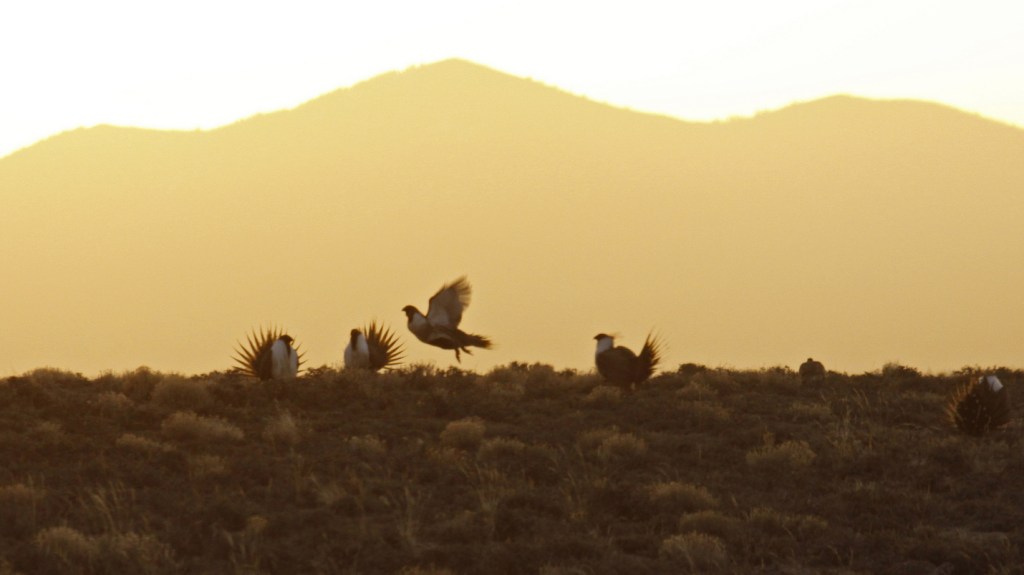When it comes to romance, how loud is too loud?
“So what you’re saying is, don’t vacuum a sage-grouse lek?” I asked.
“And don’t grind coffee in the middle of one either – it’s not a good place for your next hipster drip-coffee spot,” Kevin added.
Michael, our boss, walked into this conversation to ask an administrative question about the sage-grouse project we’re working on. “Usually I can track the context of your conversations, but what on Earth are you two talking about?” he inquired with a smile.
We laughed. These kinds of conversations tend to get us a little giddy and energized – the way you feel when you find the solution to a problem or wonder at a new, fascinating component of a complex world.
We were discussing how ambient and human-made sounds affect mating sage-grouse, and how to address those effects. Before long we’d be diving into some pretty heady physics including prevailing winds and how different pitches (like notes on a piano) might affect the birds. For now, we were just trying to wrap our heads around a simple question: How loud is too loud? To help this sink in, I was trying to imagine my life as a sage-grouse.
Biologists cringe when we assign human attributes to animals too much. It can lead us to oversimplify a complex set of relationships in the natural world and elevate human experience above all others. Be that as it may, it’s a useful tool and our more creative instincts have long allowed for metaphors to illuminate difficult concepts. Plus it’s a little silly and kind of fun.
My life as a sage-grouse, in the most basic form, is pretty simple. I have a home to sleep in and to be with my family and loved ones, and for this I require cover and security to thrive – which roughly translates to nesting habitat. I frequent a grocery store (or maybe I even have a garden) to get nourishing food for myself and the people around me. This store or garden is a sage grouse’s “late brood habitat,” where hens take chicks to find insects, so they can grow into stout little birds.
But what are leks like?
Leks are our bars, cafés and music venues where we go out seeking companionship. Every spring sage-grouse flock to these open areas and males display themselves – puffing out their chests and making a low whoompa-whoompa sound. The parallels to the human experience are endless here, and I will leave many of them to your own imagination!
But in all seriousness, I’m humbly reminded of how hard it is to get to know someone at a loud, crowded bar, or at a raging music concert. You can’t understand what the other person is saying over all the hubbub, you can’t tell the other person how much you like them and ask about who they really are. You simply can’t hear them.
When we really want to get to know someone, we can invite her or him to a quiet café, a walk along the river, or to a cozy pub where we can dig into the stuff that really matters. We ask questions of each other that probe deeper, getting at our values and perspectives of the world. We ask each other to be vulnerable and, in return, we listen, quietly and openly.
Imagine that you are on a date that is going well at a local restaurant – candles, soft conversation, a glass of wine. You are deep into a discussion about the things that really matter. At this moment even loud laughter from other diners can feel jarring and abrasive and disturb the mood. It is a magical evening. Suddenly, the wait staff starts running a vacuum cleaner right next to your table. What do you do? Want to move, most likely. You want to find a quiet place around the corner to enjoy your conversation and each other.
Sage-grouse can pick up and move when a lek is disturbed by noise, too. But the problem is, we don’t know where they go, and we don’t know how new leks get established. Which brings us back to our question: How much sound is too much?
The scientific literature suggests that leks become abandoned when noises are 10-30 decibels above ambient noise. But how loud is that? It’s somewhere between normal human conversation and the sound of a vacuum cleaner, or a coffee grinder, or 18-wheelers on a roadway.
Sage-grouse numbers have been dwindling dramatically over the last 100 years, so we have a lot more measurement and modeling work to do to avoid this habitat impact. And Kevin and I will have many more conversations, about how to accomplish this, and we will drill down on the acoustics, and the math and physics that underlay the phenomenon.
For now, I can say that I get it. I sympathize with the birds on this one. I would leave if the mood wasn’t right and I definitely won’t be running a vacuum cleaner across a lek!




Great article Liz. Studies in Wyoming indicate that ambient is around 12-15 decibels and that the effects on lekking grouse are shown at around 25 decibels. Look for new published research by Patricelli and Ambrose on this soon.